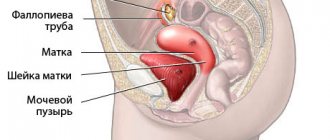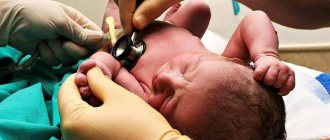In this section you will learn:
- How often does it occur?
- Causes of miscarriage
- Symptoms
- Stages
- Possible complications
- How to diagnose
- How to treat
- Recovery after treatment
- Prevention
An unexpected termination of pregnancy in the first trimester, accompanied by pain and bleeding, is called spontaneous abortion, or miscarriage. This dangerous condition not only stops the development of the embryo, but also threatens the life of the woman. The consequences of a miscarriage damage the reproductive organs and reduce the chances of becoming pregnant in the future.
Miscarriage - what is it?
The word miscarriage refers to the expulsion of the fertilized egg from the uterine cavity, which occurs before the 22nd week of pregnancy. Miscarriage is considered the most common complication of pregnancy - up to 25% of pregnant women lose at least one pregnancy. Miscarriage is diagnosed based on ultrasound.
Every second miscarriage occurs in the preimplantation period, i.e. before embryo implantation. The higher the gestational age, the lower the risk of miscarriage. At the point when fetal heart function has already been detected during ultrasound examination, the risk of miscarriage is only about 3%.
Types of miscarriages
Symptoms of miscarriages and changes occurring inside the uterus make it possible to divide this pathology into several types:
- Threatening miscarriage
. Its typical feature is the presence of painless discharge. If uterine contractions do occur, they are usually of low intensity. This type of miscarriage is also associated with characteristic features found during a gynecological examination of the patient. During this examination you can expect: changes in the cervix, uterine bleeding, an enlarged and sometimes tense uterus. - Miscarriage in progress
. At this moment, pain and bleeding from the uterus appear. During a gynecological examination, the doctor detects changes in the cervix. Elements of the fertilized egg may already be visible at the exit. - Stopped miscarriage
. This is a situation where within 8 weeks after the death of the fetus, it is not expelled from the uterus. A symptom of this type of miscarriage is the absence of enlargement of the uterus for several weeks, which is associated with a lack of weight gain in the dead fetus. When performing an ultrasound examination, there is no fetal heart function.
Three or more consecutive miscarriages are called recurrent miscarriages.
Miscarriage should not be confused with spontaneous abortion, which means that the pregnancy ends spontaneously without external or medical intervention, injury, medication or pharmacological abortion. Spontaneous abortion is a term often found with the definition that miscarriage is the spontaneous termination of pregnancy.
Is there any prevention?
Pregnancy after a spontaneous miscarriage can occur and be quite successful. But first the cause of the abortion must be established. If these are genetic problems, endocrine pathologies, problems with the blood or the uterus, then it is necessary to undergo special treatment. But there are general recommendations that will help reduce the risk of miscarriages:
- After termination of pregnancy, a woman needs to rest well, gain strength, take a course of vitamins, possibly oral contraceptives, prescribed by the doctor. It is best to plan your next pregnancy after about 6 months.
- You should lead a healthy lifestyle.
- Do not smoke or drink alcohol.
- Exercise regularly.
- Take vitamins and balanced meals.
- Visit your gynecologist regularly.
- Have fewer stressful situations, give up heavy physical activity.
- Reduce work with harmful substances and poisons to a minimum.
- Normalize weight if it is too small or, on the contrary, too large.
- Consultations with a psychologist and psychotherapist are possible.
Spontaneous abortion is an unpleasant phenomenon that can happen to every woman. But it is necessary to carry out treatment correctly and consult a doctor on time. In addition, preventive measures should be taken.
Symptoms of miscarriage - vaginal bleeding
Minor spots or spotting, especially in the 1st trimester of pregnancy, is usually not a big cause for concern - this is implantation bleeding. But if there is more blood - it is visible on underwear or a pad, if pieces of tissue or clots are visible in it - you should immediately contact a gynecologist, since such bleeding carries a high risk of pregnancy loss.
- Contractions of the uterus.
If unusual discharge or bleeding is accompanied by uterine contractions, especially if they are painful and regular, you may be experiencing symptoms of miscarriage. Differential symptoms are hardening or itching, tingling of the abdomen. These are, as a rule, symptoms of prognostic contractions, which represent the preparation of the uterus for childbirth. - Abdominal pain
. Pain in the lower abdomen during pregnancy is always a cause for concern. If the uterus hurts, that is, the organ that is initially located below the navel, and then expands, reaching the ribs, there is a threat of pregnancy. The symptom of a miscarriage is not a pulling in the groin, tingling, a feeling of pressure or pressure on the perineum - these symptoms are typical for the end of pregnancy and you do not have to worry about them. - Unusual symptoms.
Many women who have lost a pregnancy, especially at the 6-10 week stage, report a sudden cessation of pregnancy symptoms. Pregnant women who felt nauseous and tired suddenly feel great, and when visiting a gynecologist they find out that the fertilized egg has died.
Unpleasant pregnancy symptoms gradually calm down from the 8th week of pregnancy. After the 10th week they are already quite weak, and usually disappear completely after the 12th week of pregnancy. If a woman feels anxious in early pregnancy, she should have an ultrasound done.
What consequences?
Typically, spontaneous miscarriage in early pregnancy carries certain risks. The consequences of spontaneous miscarriage can be different:
- Heavy bleeding, pain.
- Infertility.
- But the most difficult and life-threatening miscarriages are those that a woman causes herself, at home. If they are not treated and the consequences are not eliminated, they can result in the woman’s death.
Usually, if the patient was provided with high-quality medical care, there are practically no complications. After about 10 days, the bleeding stops, and after 4 weeks the woman begins her normal menstruation.
Causes of miscarriages
The causes of miscarriage are varied:
Genetic factors.
An important group of causes of miscarriage are genetic mutations associated with changes in the number of chromosomes and the result of their abnormal structure. Sometimes genetic abnormalities occur in one of the parents and are passed on to the embryo. It often happens that abnormalities that occur in parents cause repeated miscarriages. Genetic abnormalities are recognized as the most common cause of spontaneous abortion.
Luteal deficiency.
The corpus luteum is a structure formed from an ovarian follicle and is responsible for the production of progesterone, a hormone that prepares the endometrium for embryo implantation. Progesterone is also responsible for the proper development of early pregnancy. Progesterone deficiency, resulting from corpus luteum deficiency, prevents the embryo from implanting in the endometrium. Progesterone itself is also responsible for the proper preparation of the mucous membrane for the implantation process.
Anatomical abnormalities.
Another factor influencing the development of miscarriage is anatomical defects, the frequency of which is up to 2%. Anatomical factors predisposing to miscarriage:
- bicornuate uterus or septate uterus - these defects can prevent embryo implantation;
- adhesions inside the uterine cavity, arising, for example, as a result of uterine curettage;
- uterine fibroids;
- pelvic endometriosis – the presence of endometrium outside the uterine cavity.
Miscarriage and autoimmune diseases.
Immune factors also play an important role in the pathogenesis of miscarriage, for example, antiphospholipid syndrome, characterized by the presence of antiphospholipid antibodies in the body, recurrent miscarriages, a reduced platelet count and a tendency to form blood clots.
The presence of antiphospholipid antibodies increases not only the risk of miscarriage, but also the risk of other obstetric complications, which include:
- pregnancy-induced hypertension;
- premature separation of the placenta;
- intrauterine fetal growth restriction.
In women with antiphospholipid antibodies and recurrent miscarriages, pharmacotherapy is used. As a rule, acetylsalicylic acid and heparin are administered. This treatment prevents thrombotic complications and significantly increases the chances of maintaining pregnancy.
Age of the pregnant woman.
With age, the risk of miscarriage increases. The miscarriage rate in women over 40 years of age is up to 50%. The older the pregnant woman, the higher the risk of genetic abnormalities in the fetus, which increases the risk of miscarriage. Also, older women have poorer oocyte quality.
Infections.
Infectious factors that increase the risk of miscarriage include:
- Rubella virus, cytomegalovirus, herpes virus;
- Measles virus – if infection caused by this virus is favored by high temperature, then this is a significant risk factor;
- Toxoplasma gondii toxoplasma is a protozoan responsible for the development of toxoplasmosis. Congenital toxoplasmosis is associated with the occurrence of serious defects, which include microcephaly, inflammation of the retina and choroid. Infection of the fetus with this protozoan also increases the risk of miscarriage;
- Bacteremia is the presence of bacteria in the blood of a pregnant woman. Toxins produced by bacteria penetrate the placenta, leading to fetal death and miscarriage.
It is worth knowing that regardless of the pathogenic factor (i.e. virus or bacteria), the fever itself predisposes to the onset of uterine contractions, which contributes to miscarriage.
Miscarriage - risk factors during pregnancy
Prognosis factors associated with the course of pregnancy that have a significant impact on the risk of miscarriage:
- Location of the gestational follicle
. Follicles located above the internal ostium are more prone to miscarriage than those located below. The location of the gestational follicle can be assessed using ultrasound; - Fetal heart function
. Decreased fetal heart function – bradycardia – is an unfavorable prognostic symptom; - Bleeding
. An unfavorable prognosis factor is bleeding lasting 4 days or more; - Human chorionic gonadotropin (beta-hCG) level.
Lack of growth or a decrease in the level of this hormone is an unfavorable prognosis factor, indicating the presence of a dead fetus. Under normal conditions, the concentration of human chorionic gonadotropin increases every 48 hours by approximately 66%. This hormone is produced by the embryo, and its greatest secretion occurs in the 10th week of pregnancy. Slower growth indicates fetal abnormalities.
Another pregnancy after a miscarriage
If spontaneous abortion occurs in the case of the first pregnancy, doctors usually do not prescribe any specialized examinations. Efforts for another pregnancy can begin at the next ovulation, 2-6 weeks after the miscarriage.
If during a miscarriage it becomes necessary to curettage the uterus, the doctor will tell you when it will be possible to return to trying to conceive a child and to sexual relations in general. The chances of a healthy pregnancy after one miscarriage are estimated at 80-87%, and a second at 72-82%.
How to carry out treatment?
How to treat a spontaneous miscarriage depends on the type of miscarriage. If it is threatening and has begun, then the following must be taken:
- The woman must be in hospital.
- A diet that contains all the necessary minerals and trace elements.
- The patient must remain in bed.
- Sedative medications and drugs that relax the muscles of the uterus should be prescribed.
- If abortion is “in progress,” then all measures must be taken to stop the bleeding.
- If the abortion is complete and incomplete, then everything “unnecessary” that is in the uterus should be removed. For this purpose, curettage can be used.
- If there is a failed abortion, then sometimes they use expectant tactics, when they wait for everything to “come out of the uterus on its own.” And sometimes they do curettage.
- Also, sometimes during a frozen pregnancy, expectant management can be used, especially for nulliparous women. Then after about 4-6 weeks a spontaneous miscarriage may occur. Sometimes drug treatment is used, in which special pills are used to help complete the pregnancy. And sometimes they do surgical curettage.
In any case, abortion should not be left to chance; you must consult a doctor who will choose a treatment tactic.









